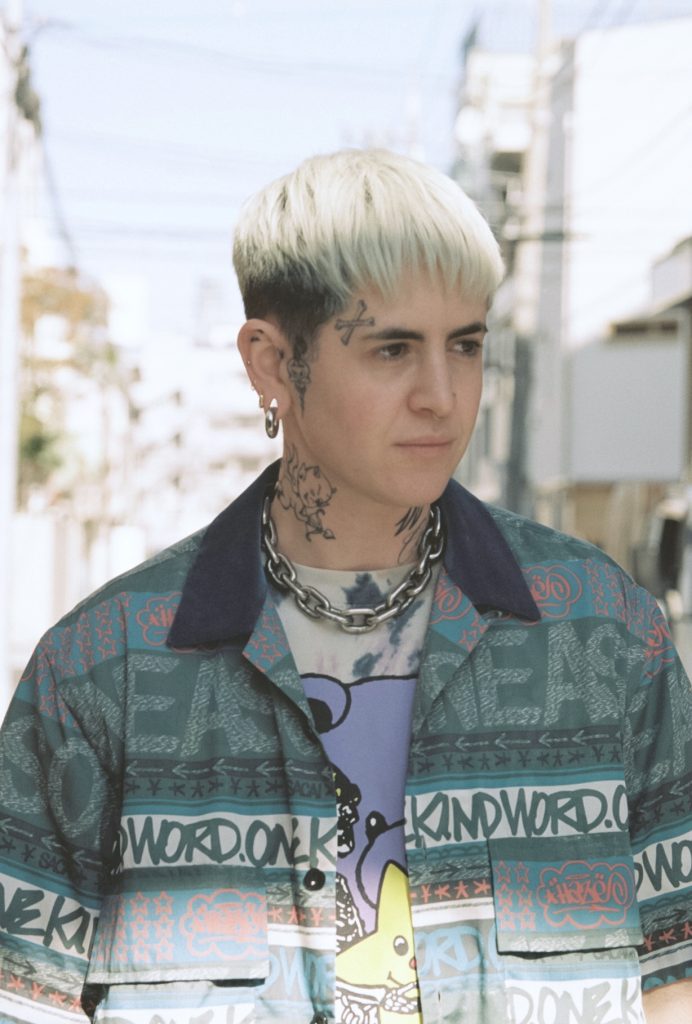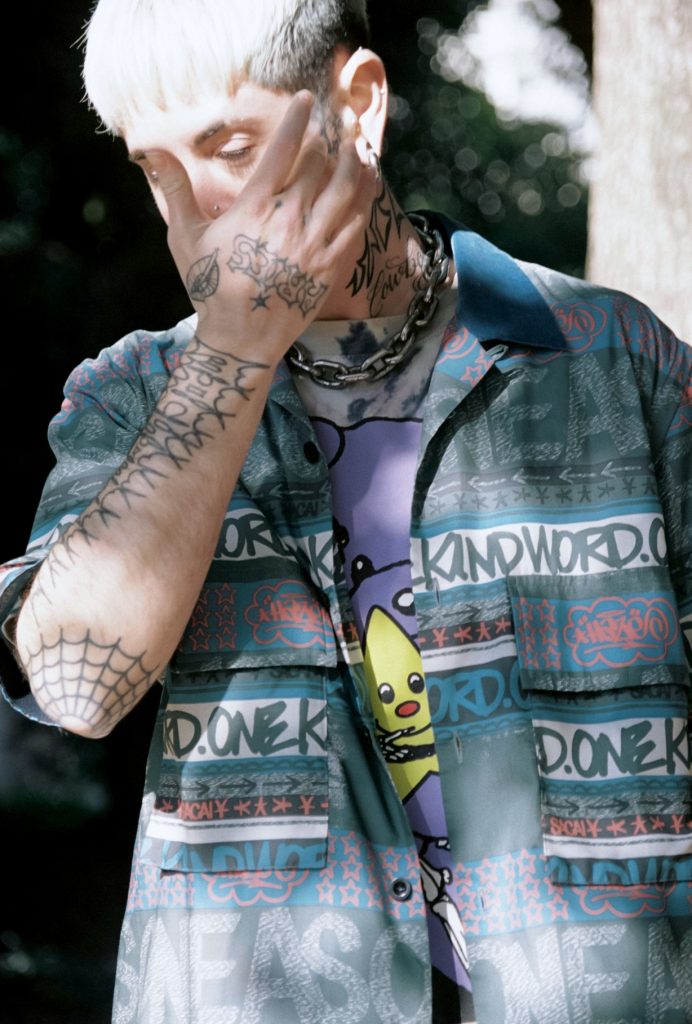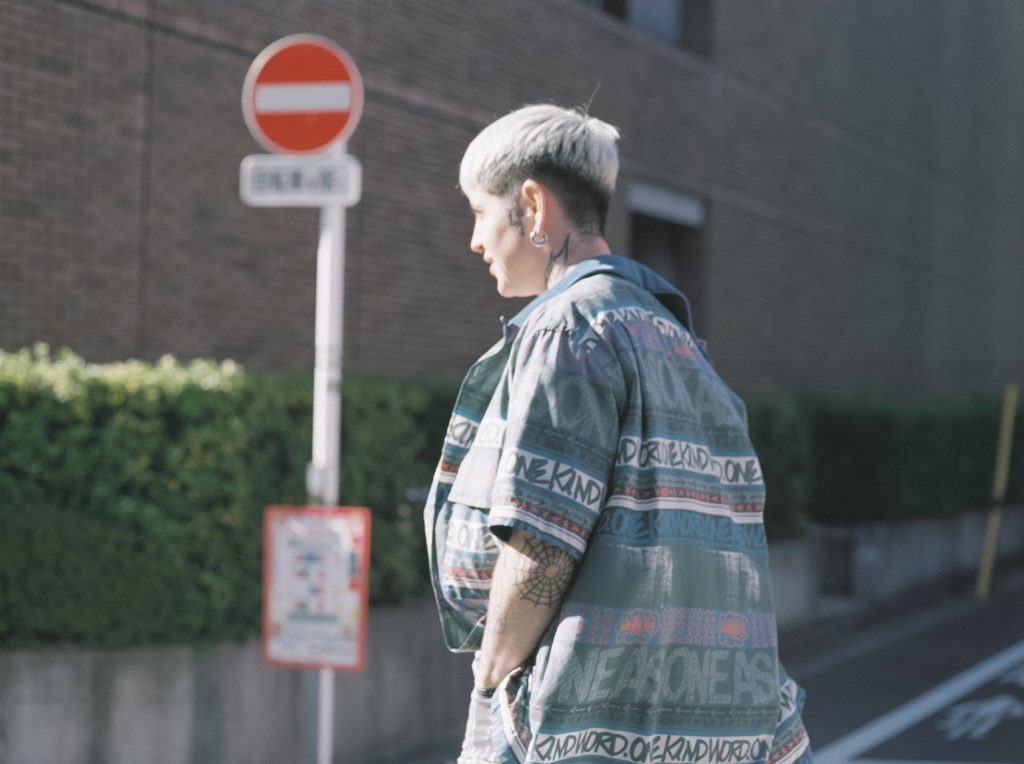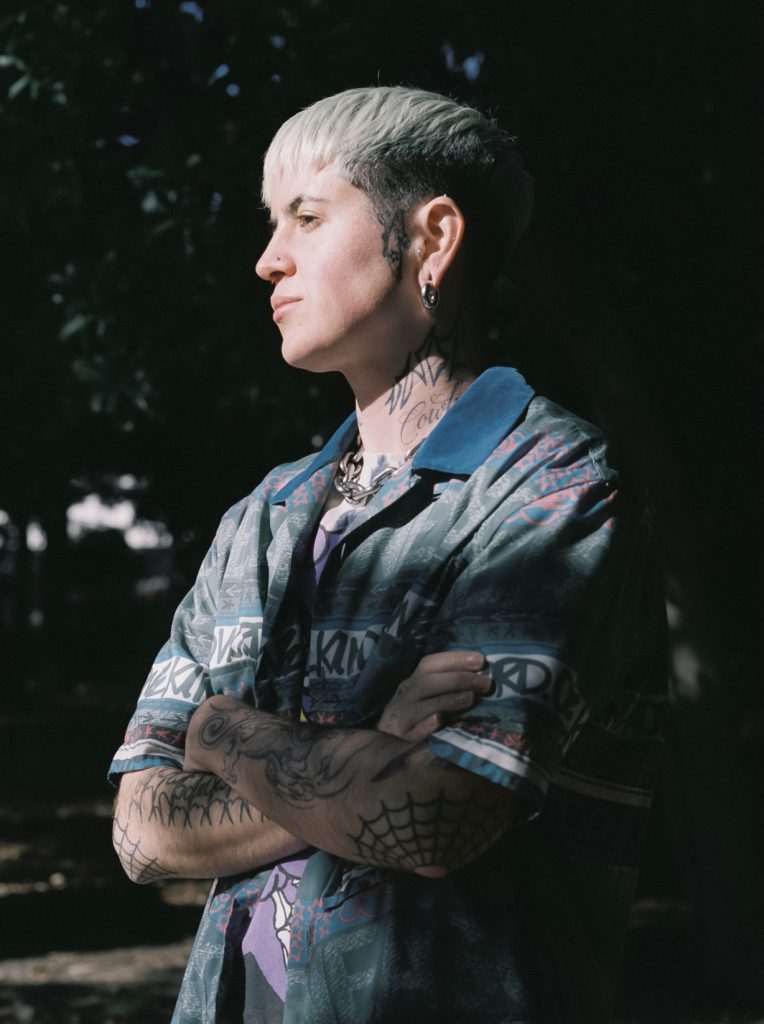June is referred to as “Pride Month” in a lot of countries, with many events held to raise awareness about LGBTQIA+ rights. The roots of Pride Month can be traced back to the Stonewall Riots (A series of resistance movements against the persecution of LGBTQIA+ people by the authorities), which began with a police raid on the Stonewall Inn, a gay bar in New York City, on June 28, 1969. Since then, many parties, researchers, and activists have invested a great deal of time and effort to advance the rights of the LGBTQIA+ community.
British designer and creative director Aries Moross is one of them. Aries emerged at a young age with their energetic design works incorporating hand-drawn illustrations and lettering and has successfully led a number of big projects, centered on creative direction in the music industry. In addition, as a transgender person who has undergone gender-affirming procedures and the owner of their design studio, Studio Moross, Aries is a thought leader in the industry, speaking on various occasions to raise awareness about the LGBTQIA+ community and to improve the working environment in the creative industry.
Besides, Aries has close ties with Japanese culture, having worked on many projects in Japan, collaborated with singer AI for her album Wa To Yo, and owns two Shiba Inu dogs. We asked Aries about various topics, such as their upbringing, sources of creativity, thoughts on Japanese culture, and even why they are politically outspoken. In Part 1, Aries shares stories around their roots, style, aesthetics and design as a career. Please also check out the portraits of Aries taken by photographer Yoko Kusano specifically for this interview

Aries Moross
Aries Moross is a creative director, illustrator and designer. Moross began their career in 2007, illustrating hand drawn flyers for London’s independent music scene, and in 2008, established a vinyl only record label. Keen to expand their practice and build a team, they founded Studio Moross in 2012. Over the course of their career, they’ve maintained close ties to the music industry whilst expanding into the realm of both art and creative direction. Moross has taken on the role as creative director for a range of clients from pop artists to DJs, with projects spanning everything from album campaigns to live shows. Notable clients include Kylie Minogue, H.E.R, Disclosure, Spice Girls, Jessie Ware, and London Grammar. Aries also works in the live music sector as a show director, directing shows for Disclosure, London Grammar and Kylie Minogue.
http://www.ariesmorros.com
http://www.instagram.com/ariesmoross/
http://www.studiomoross.com
I would be too bored if I had to do the same thing
— Thank you so much for having us today, Aries. I’m sure quite a few people in Japan have seen your artwork, but most of them don’t have a concrete idea about who you are. So, can you introduce yourself briefly?
Aries Moross (Aries): Sure. But I do a lot of things, which I think can make it harder for people to connect dots. But that’s the way I like to practice. I would say, first and foremost, I’m a designer, and that encompasses illustration, graphic design, product design, textile design, any form of image making and designing. But I’ve also worked as a creative director for musicians, live shows, campaigns for album releasees and festivals. And I run a studio in London called Studio Moross. We’ve been open now for 11 years, working in music and television, doing graphics, illustration, and branding. I like to do lots of things, the downside of that is maybe people don’t know or understand what I’m doing. But that’s okay. I’m enjoying my job. That’s the most important thing. I would be too bored if I had to do the same thing.
— Can you explain why you came to Tokyo this time?
Aries: For me, I’ve always enjoyed working here in Japan and I feel like it’s important to be here and meet people. Even though digital spaces have allowed for online meetings and remote working, I wanted to come because I love Japan. So I’m here for visiting and meeting with people I’ve been working with or would like to work with and get to know the country even better. So, work and leisure.
— Can you share any recent project in Japan?
Aries: Yeah, I’ve been working with The Bee’s Knees Inc. for a long time. We’ve been collaborating on Japanese specific projects, and international projects together. Most recently, I was one of fifteen artists participating in the project to celebrate the fifteenth anniversary of stationary manufacturer MIDORI’s MD Notebook.
I was an insatiable kid who could never be satisfied

— Can you tell us what kind of child you were? And how does your childhood connect to who you are and how you work now?
Aries: I was an insatiable kid who could never be satisfied. I was always wanting to create things and entertain myself with miniature toys, making things, drawing. I was a very chaotic, very playful, and very creative kid who was always making books, dollhouse furniture, anything I could come up with, lots of drawing and crafts. I’ve always enjoyed that sort of outputs. And that has carried over to me as a grown-up.
— I see. Family environment must have been a significant factor for you to become who you are. Did your parents encourage you to be creative?
Aries: My mum recognized from my young age that I needed a lot of creative stimulation. So, she used to hire art students who would babysit me. So instead of regular old lady babysitter from down the road who would watch TV with kids all day, she would get art students who would make things and draw with me. So I was very much encouraged by my family and parents to continuously be creative. When I was younger, I’m 37 now by the way, perhaps it was less realistic to become a creative as a career than it is now because being creative was a very strong career choice. Nevertheless, even though my parents come from a more academic background, they were still excited and keen for me to be creative. So, instead of saying “you need to do maths and English,” they were happy for me to explore design and art.
— Since your works are very diverse, it’s difficult to simply define your style, but your body of work still has a consistency. They incorporate a lot of hand-drawn lettering and graphics and vivid and lively color hues. Do you think you can name specific thing, people, or experience that hugely influenced you to establish your style?
Aries: I was always a doodler who would always draw nonsense in my notebook when I was younger. Although I was okay at drawing, I was better at lettering. So I really enjoyed working with words and writing, even though I was not very good at writing itself. And it definitely led to nurturing my strength as a creator. I’ve always incorporated drawings and letterings into my work. Although I started to feel limited in that world and wanted to explore more things at some point, I still very much like hand-made work. Anyway, my hand writing has represented so many brands and projects, and people sometimes borrow my hand writing to represent their handwriting. It’s kind of innate to who I am. I can’t help using it in my work.
— Interesting. In the early stage of your career, you worked with then independent bands like Animal Collective and Mystery Jets. And now, you are working with incredibly famous artists releasing their music on major labels. How have your own musical taste affected your choice of client?
Aries: First and foremost, I’ve got a very broad music taste. For me I have to be able to connect with artist as a person. It’s really important for me to connect with them not just in a mechanical business relationship.
I worked with Mystery Jets actually quite closely. In terms of Animal Collective, that was just a party flyer. I did a lot of flyers back in 2007-8. But now for me, it’s important to connect with the theme and concept, to earn trust from the artists, and to have space to create a world. I like to build the world around the albums, whether that’s for packaging for vinyl and CDs, or merchandise. And I enjoy working for artists that have big audiences and whose scale of output is bigger. That’s why I lean towards artists like Kylie Minogue, because she would release ten vinyl records, whereas other artists might make one.
And I really like the opportunity of creating as many ways that fans can interact with an album, whether that would be through a live show, a record that they can listen to at home, or T-shirts they buy in the shop. I’d like to sew everything together.
Focusing on “the span,” rather than on “the depth”

— I learned that in your university days, you were often told that you need to focus on “the depth” of your creation, but you were more interested in “the span.” Can you say a bit more about that?
Aries: Yeah, my tutor said that to me. I went to Camberwell College of Arts, which was very much pushing me towards conceptual design. Although I was very interested in that, I also had the eye of a business person. I was aware that artistic practice and conceptual design practice were not hugely commercial, and I wanted to make a living, I wanted design to be my career. So, I also enjoyed and developed an appreciation for more broad and commercial design, which I thought was a valid form of creativity. It might not be as intelligent as conceptual ones, it might not have any researcher writing an essay about it, but it is accessible and serves a purpose in society. It’s a kind of design that everyday people interact with and have an appreciation for. So for me, it’s very important for the design world to be more superficial, fun, and carefree. Nonetheless, I still think, some of the things I learned at university were very important in my design practice. Semiotics, for instance, it helped me a lot in understanding the meaning behind things. But I was a rebel at school, and the teachers were always a bit annoyed with me for doing my own things (laughs).
— Haha. In a university environment where conceptual and academic contexts were seen as important, you chose a form of expression that was accessible to many people and became a designer while also making use of your studies there, and this process is now reflected in your current work. What do you think is the difference between being involved in a project as a designer or creative director and collaborating with a company as an artist?
Aries: In terms of artists, when they work on a specific commercial project, they lend their artistic brands to projects. However, I can be one step further away from a project, and can work more like a creative producer, in a way that my name is not necessarily associated with the project. So, I have a lot more freedom in as much as I can work on things without people even knowing I’ve created something or been part of it. But then I can also choose to be more of a figurehead and be more outwardly endorsing a product or a project. So I am lucky that I get to explore both of those things. Whereas, named artists, or they have to make more difficult decisions about what they lend the creativity to.
— So, does that mean you don’t necessarily care whether or not having your name on the campaign now?
Aries: Not really. But it’s tricky because when I started my career, it was very important to sell my name. And I guess I always tried to be ahead of myself and the industry at large.
And I realized that the day of the Rockstar illustrator was short. I mean, the career of practicing illustrators tends to be very finite, except for a few people who transcend their careers and become artists whose works can be auctioned for a hundred thousand dollars, after getting picked up by major galleries or major celebrities. So, I realized quite quickly, that just having a name known isn’t really that valuable, and that the important thing is to have a legacy and have a practice and a studio and educate other people on how to create work and build more of a long-term foundation for the work I want to make, rather than being ruled by trends and fashion, which is also very ephemeral.

— As an independent creator, you carefully analyzed the situation of the industry at a young age when you tended to focus on making a name for yourself and decided on the path you should take, right?
Aries: Maybe yeah. Also, we’ve seen the decline in budgets for projects. A decade ago, you could get big money for a collaboration with a brand and now the budgets are 10% of that, meaning that you sell your name now for 90% less money. And that means you have to do more work for less.
It’s also related to the fact that the industry has become more democratic. Instagram and social media have enabled anyone to have a career in design and art. The gatekeepers of them were the art buyers, reps and the agents who would hang onto all the creatives and show them to the ad agencies and the clients. But now, that structure still exists, but it’s no longer an exclusive network. So everything changes all the time, and I’ve always been thinking a lot about the future.
I might have earned a lot more money or become more widely known. But I would have been less happy. And I would have not been able to create the big and exciting projects that I get to make now as part of the studio. It allowed me to design tours and direct live shows and travel the world and experience things and have deep and creative relationships with other creative people, as opposed to sitting on my own in my house with a pen and paper, which now feels more like a hobby than a career for me.
— So you’re still drawing your illustration?
Aries: Yeah, mostly for myself. I’ve started to go back to it now. And here in Japan, I’ve been drawing a lot. I’m drawing trees because the trees here are so beautiful. I’ve been sitting in parks, sketching trees just for myself.
The second part of the interview is available here.
Photography: Yoko Kusano
Stylist: Megumi Yoshida
Special thanks: Risa Nakazawa (The Bee’s Knees Inc.)
【Information for Aries’ style】
Shirt ¥48,400 supplied by sacai (sacai:03-6418-5977)
Any other items worn by Aries are of their own

